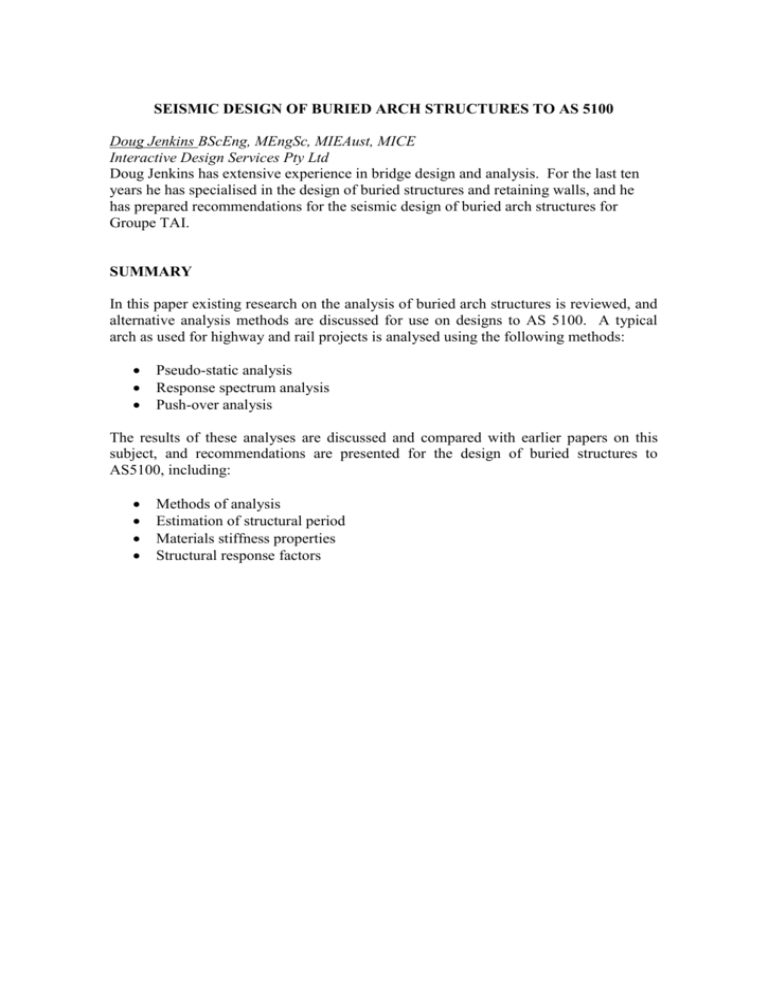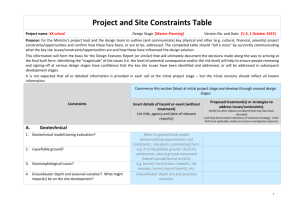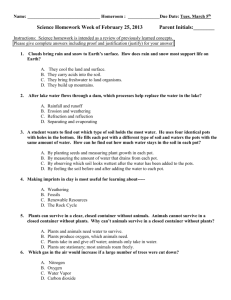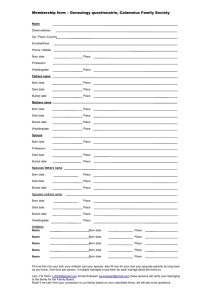Seismic design of Buried Structures to AS5100
advertisement

SEISMIC DESIGN OF BURIED ARCH STRUCTURES TO AS 5100 Doug Jenkins BScEng, MEngSc, MIEAust, MICE Interactive Design Services Pty Ltd Doug Jenkins has extensive experience in bridge design and analysis. For the last ten years he has specialised in the design of buried structures and retaining walls, and he has prepared recommendations for the seismic design of buried arch structures for Groupe TAI. SUMMARY In this paper existing research on the analysis of buried arch structures is reviewed, and alternative analysis methods are discussed for use on designs to AS 5100. A typical arch as used for highway and rail projects is analysed using the following methods: Pseudo-static analysis Response spectrum analysis Push-over analysis The results of these analyses are discussed and compared with earlier papers on this subject, and recommendations are presented for the design of buried structures to AS5100, including: Methods of analysis Estimation of structural period Materials stiffness properties Structural response factors INTRODUCTION Buried arch structures are frequently used in Australia as alternatives to small span bridges, and for cut and cover tunnels. They often form part of vital transport links, and in many cases failure of one of these structures would potentially result in severe consequences; however the new Australian Standard Bridge Code (AS 5100) provides little guidance on the seismic design of buried structures, and there is little published research on this subject. In this paper alternative analysis methods are examined, and recommendations are given for the application of AS 5100 to buried structures. AS 5100 REQUIREMENTS FOR SEISMIC DESIGN The new Australian Standard Bridge Code, AS 5100 (1) in general follows the principles adopted in Part 4 of the SAA Loading Code, AS 1170.4 (2), with the following main differences: Specific rules are given for the categorisation of bridges. A formula is given for the fundamental period of bridge structures (for use in category BEDC-1 designs only). Specific structural response factors are given for bridges of different types. Structural detailing requirements relevant to bridges are given. The following difficulties arise in the design of buried structures to the requirements of AS 5100: The requirements for more detailed analysis methods are related to bridge span, and may not be relevant to buried structures. Vertical earthquake effects may be important for buried structures, but the code only requires horizontal effects to be considered for almost all buried structures. The formula for the fundamental period is not applicable to bridge structures. For static analysis the earthquake design force is not applicable to buried structures. The appropriate response modification factor is not clear. Figure 1 Collapsed underground structure; Kobe Earthquake 1995 Page 25- 1 EARTHQUAKE PERFORMANCE OF BURIED STRUCTURES It is widely accepted that flexible buried structures have good performance under earthquake loading and that such structures are able to accommodate the deflections imposed by the ground vibrations without failure. There are cases of structural failure and total collapse of buried structures however (see Figure 1). Potential causes of failure of a buried structure include: Liquefaction of the foundations or the surrounding soil. Compression failure of concrete and/or compression reinforcement. Buckling of compression members due to excessive deflections. PREVIOUS RESEARCH A precast concrete buried arch of approximately 10 m span and 5 m height was analysed by Byrne et al (3) under a range of fill heights and seismic loadings. This work was reviewed and extended by Wood and Jenkins (4), concluding: “Results show that the bending moments in the arch from horizontal earthquake loading can be significant in relation to the gravity load actions. These moments are also very sensitive to the backfill and surrounding soil stiffness properties and rather less sensitive to the foundation soils beneath the arch.” STRUCTURE AND ANALYSIS METHODS A typical arch as used highway and rail projects was analysed using a pseudo-static analysis, and a response spectrum analysis. A push over analysis was also carried out up to the maximum deflection found in the previous analyses. The arch dimensions were: Internal span,13 metres; internal height, 8 metres; thickness, 300 mm. The analyses were carried out with 3 metres and 15 metres of fill over the crown of the arch. The main features of the model were: The model was extended so that the boundary of the fill was a distance of more than 5 times the arch span from the outer face of the arch. The arch was modelled with beam elements, and the fill with 8 noded plain strain plate elements. Frictional interface elements were placed between the arch and soil to allow slip to take place at the interface. For the static analyses, the soil was placed in layers, to model the construction sequence of the arch. The static analyses used Mohr-Coulomb properties for the soil. The arch was modelled with either linear elastic properties, or a moment-curvature relationship taking account of the concrete and reinforcement properties and the estimated axial load in the arch (Figure 8) For each fill height the following analyses were carried out: 1. Natural frequency analysis 2. Deflection under unit horizontal acceleration Page 25- 2 3. Pseudo-static analysis 4. Response Spectrum analysis 5. Push-over analysis For each of the analyses the following material stiffness properties were used: 1. Typical soil and uncracked concrete. 2. Soil stiffness reduced by half and uncracked concrete. 3. Soil stiffness reduced by half, and concrete moment-curvature relationship (static analyses), or cracked stiffness (response spectrum analyses) A total of 26 separate analyses were carried out. SEISMIC PARAMETERS The following seismic parameters were assumed for the purposes of this paper: Acceleration coefficient, a: 0.10 Site factor, S 1.5 Bridge type: II (Bridges that are designed to carry large volumes of traffic or bridges over other roadways, railways or buildings) From Table 14.3.1 of AS 5100 Part 2, the bridge classification was BEDC-2. The code only requires vertical earthquake loads to be considered for spans greater than 35 metres for this category. ANALYSIS RESULTS The fundamental period for each structure, and the horizontal deflection at the ground surface above the arch crown under 1.0g horizontal acceleration, are shown in Table 1. Regression analysis showed that the fundamental period may be estimated using the relationship: T = 0.055 0.5. This relationship was found to give results within 2 percent of those found from the dynamic fundamental period analysis in this case, and has been found by the author to give reliable results for a range of other buried structures. The results of the analyses for bending moments are summarised in Figures 2 to 7. The response spectrum maximum moments were higher in general, by up to about 50%. Maximum horizontal deflections at the crown were 90 mm for 3 metres cover and 103 mm for 15 metres cover. 3 metres cover Elastic Reduced soil Reduced both Period, T 0.605 0.850 0.853 Elastic Reduced soil Reduced both 0.999 1.405 1.408 119 231 233 0.055 0.5 0.600 0.836 0.840 Stat T /Dyn T 99.1% 98.4% 98.4% C 0.261 0.209 0.208 101.7% 102.0% 101.8% 0.188 0.149 0.149 15 metres cover 341 679 680 1.016 1.433 1.434 Table 1, Fundamental Period, T Page 25- 3 The greater axial load in the arch under 15 metres of cover resulted in a greatly reduced ductility (Figure 8). The maximum horizontal displacement of this structure in the push-over analysis was approximately 190 mm, with a maximum bending moment of 590 kNm (Figure 9). The ductility ratio (curvature capacity / maximum curvature) was 23 for 3 metres cover and 3.4 for 15 metres cover under horizontal earthquake loading. The seismic increment in axial load under vertical earthquake loading was about 350 kN for 3 metres cover, and 1100 kN for 15 metres cover. The results of the pseudo-static analysis were within about 10% of the response spectrum analysis. The ductility ratio reduced to 17 for 3 metres cover and 2.8 for 15 metres cover under combined horizontal and vertical loading. CONCLUSIONS AND RECOMMENDATIONS Buried arch structures with low to moderate axial load are unlikely to fail under earthquake loading, because of the large reserve ductility available in the concrete section. However where axial loads are sufficiently high for the failure mode to be concrete compression failure there is little reserve ductility, and failure under earthquake loading is a possibility. It is therefore recommended that the structure classification be related to fill height, rather than span, and that the Structural Response Factor, Rf, be reduced for structures with high axial load. For concrete structures it is suggested that Rf be related to the capacity reduction factor, , such that Rf = 5 where = 0.8, reducing to Rf = 1.5 where = 0.6. The Rf factor for vertical loads should be 1 for all buried structures. It is suggested that structures in BEDC-1 and BEDC-2 be designed for vertical earthquake loads only, using either a pseudo-static or dynamic analysis, and that those in BEDC-3 and BEDC-4 be designed for combined vertical and horizontal earthquake loads using a dynamic analysis. The fundamental period of buried structures should be determined either from a recognised theoretical approach, or for structures in BEDC-1 or BEDC-2 by application of the formula: T = 0.055 0.5 where is the horizontal deflection in millimetres of the ground surface above the arch ground when subject to a horizontal acceleration of 1g. REFERENCES (1) Australian Standard Bridge Code, AS 5100, Standards Australia, 2004 (2) Australian Standard Loading Code, Part 4, AS 1170.4, Standards Australia 1993 (3) BYRNE, PETER M., D. L. ANDERSON, and HENDRA JITNO Seismic Analysis of Large Buried Culvert Structures, Transportation Research Record 1541, TRB, National Research Council, Washington, D.C., 1996, pp. 133-139. (4) WOOD, J and JENKINS D, Seismic Analysis of Buried Arch Structures, World Congress on Earthquake Engineering, Auckland, 2000 Page 25- 4 250 200 200 Bending Moment, kNm Bending Moment, kNm 150 100 50 0 -50 -100 150 100 50 0 -50 -100 -150 -150 -200 -200 -250 0.0 5.0 10.0 15.0 20.0 25.0 0.0 5.0 10.0 Distance around arch, m Standard stiffness Reduced soil stiffness Reduced soil and beam stiff Dynamic Lin Figure 2: Pseudo-static 3m cover 20.0 25.0 Dyn, reduced soil stiffness Dyn, reduced soil&beam stiff Figure 3: Response Spectrum 3m cover 200 250 200 150 150 100 100 50 0 Standard Stiffness Reduced Soil Stiffness Reduced Soil and Beam -50 -100 Bending Moment, kNm Bending Moment, kNm 15.0 Distance around arch, m 50 0 -50 -100 0.0 5.0 10.0 15.0 20.0 25.0 -150 -150 -200 -200 -250 -250 Distance around arch, m Pseudo-Static, +ve Resp. Spect. +ve Pseudo-Static, -ve Standard Resp. Spect. -ve Reduced soil and beam stiff Figure 5: Pseudo-static 15m cover 250 200 200 150 150 Bending Moment, kNm 250 100 50 0 -50 -100 -150 100 50 0 Standard Stiffness -50 Reduced Soil Stiffness Reduced Soil and Beam -100 -150 -200 0.0 5.0 10.0 15.0 20.0 -200 25.0 -250 -250 Distance around arch, m Dynamic Lin Dyn, reduced soil stiffness Dyn, reduced soil&beam stiff Pseudo-Static, +ve Figure 6: Response Spectrum 15m cover Resp. Spect. +ve Pseudo-Static, -ve Resp. Spect. -ve Figure 7: Maximum moments, 15m cover 800 600 Bending Moment, kNm Bending Moment, kNm Figure 4: Maximum moments, 3m cover Reduced soil stiffness 400 200 0 -200 -400 -600 -800 0.0 20.0 40.0 60.0 80.0 100.0 120.0 140.0 160.0 Crown X Displacement, mm Min Moment Figure 8: Moment-Curvature Max Moment Figure 9: Push-over Analysis 15m cover Page 25- 5 180.0 200.0





